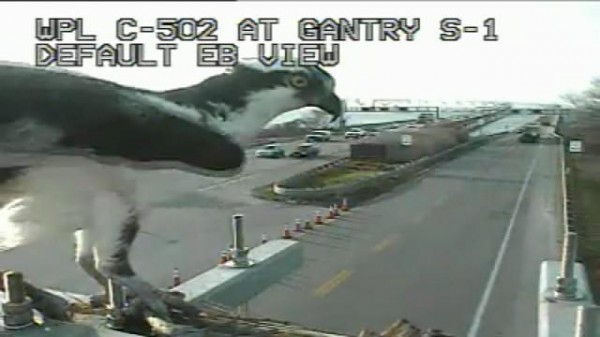The Maryland Transportation Authority has ripped the nest of a federally protected Osprey off a steel gantry over the highway, multiple times, because the nest blocks a traffic camera.
I find it kind of funny that our government will go to great lengths to protect all kinds of fish and turtles, even when the actions taken to protect the wildlife cause problems for humans, but the goverrnment not do the same when their interests are at stake.
“We’re concerned because she’s blocking one of our traffic cameras that we use for monitoring traffic conditions at the bridge,” – John Sales Spokesman for the Maryland Transportation Authority
I have a solution for the Maryland Transportation Authority. MOVE YOUR FUCKING CAMERA, NOT THE FEDERALLY PROTECTED OSPREY
If things go the way they have in other cases of federally protected wildlife, the Maryland Transportation Authority should be forced to remove their cameras from the steel gantry over the highway, and allow the Ospreys to build their nests for the eggs they need to lay.
The jackass who made the decision to rip the nest down should face criminal charges for potentially harming a federally protected bird.
UPDATE: Here is a link to the live Maryland Transportation Authority camera, which shows that they have removed the nest once again.
In the contest between bird and traffic camera, it’s a question of which will blink first.
A persistent osprey — likely in league with a mate — has been trying since late last week to build a nest smack dab in front of a traffic cam keeping watch on the eastbound U.S. 50 approach to the Bay Bridge.
The Maryland Transportation Authority has removed the nest three times, only to have the determined bird or birds return. Late Tuesday afternoon, a branch — possibly the beginnings of another nest —could be seen in front of the camera, lying on the steel gantry over the highway.
“Good grief!” said John Sales, spokesman for the authority, when informed of fresh evidence of nest building.
This isn’t the first brush with wildlife for the transportation authority, which manages the state’s toll bridges, tunnels and highways. Eagles, ospreys and even a peregrine falcon have been allowed to nest unmolested on the Bay Bridge and other structures before, Sales said. But this is the first time any have chosen to build their home in front of one of the cameras providing a live view online of cars and trucks whizzing by below.
“We’re concerned because she’s blocking one of our traffic cameras that we use for monitoring traffic conditions at the bridge,” Sales said. Authority officials also worry for the birds’ safety, he said.
“This camera moves back and forth, and we notice whenever it does that the bird gets agitated,” Sales explained. He predicted that the agitation would get worse if the female succeeded in laying eggs there.
Though many thrill to watch ospreys in flight and catching the fish that make up their diet, the birds can sometimes rub humans the wrong way when they nest in inconvenient places. They favor spots off the ground and near water, anyplace where they can pile up branches and twigs and lay a few eggs.
“Historically, before man put up all these artificial structures for them, they would traditionally nest in a dead tree,” said Glenn Therres, associate wildlife director in the Maryland Department of Natural Resources. Now, he said, ospreys have been known to nest on all kinds of human structures — piers, boat houses, even baseball backstops.
“They get themselves into some precarious situations,” Therres said. “Occasionally some nests have to be removed.”
Ospreys are abundant around the Chesapeake Bay, having rebounded over the past four decades from pesticide contamination that impaired their reproduction. They and other migratory birds are protected under federal law. So, before demolishing the traffic cam nest, transportation authority officials checked with the U.S. Fish and Wildlife Service. Sales said wildlife officials approved the evictions as long as no eggs had been laid.
The birds don’t seem to have taken the hint. That’s not surprising, said Therres, who cautioned that once a mating pair picks out a spot for a nest, the birds will keep trying again and again, despite natural or human-caused setbacks.
There may be a way to end the standoff, though, to the satisfaction of bird lovers and traffic-watchers alike. Craig Koppie, a federal wildlife biologist, visited the Bay Bridge Tuesday and said he advised state officials to try luring the nest builders away by erecting another elevated platform nearby, baited with some of the material removed earlier from in front of the camera.
“I told them just to put a handful of sticks [on it] that were dropped underneath,” he said, predicting that the birds “will go to it quite quickly. I’m sure that the osprey will be happy.”
Authority officials welcomed the suggestion, the spokesman said, though they still need a few days to see if it can be done safely.
“That’s what our hope is,” Sales said, “that this [bird’s] a newcomer and can be convinced to look elsewhere.”
Stand Up To Government Corruption and Hypocrisy – usbacklash.org

